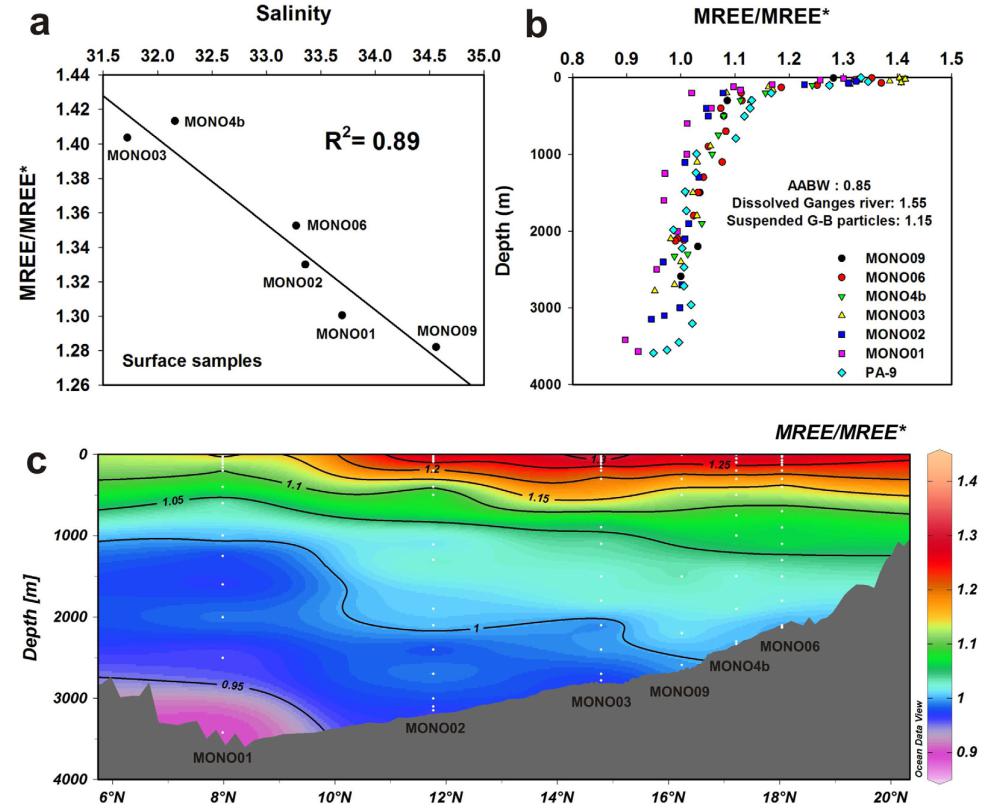Recently, the Journal “Earth and Planetary Science Letters” publishes new results from cooperative studies of vice prof. Zhaojie Yu, Prof. Shiming Wan from IOCAS with several French research partners (Université Paris-Sud, Laboratoire des Sciences du Climat et de l'Environnement, Institut de Physique du Globe de Paris-Sorbonne) titled“Antarctic Intermediate Water penetration into the Northern Indian Ocean during the last deglaciation”.
The two-stage increase in atmospheric carbon dioxide (CO2), and the associated decrease in radiocarbon (14C) during the last deglaciation, are thought to have been linked to enhanced Southern Ocean upwelling and the rapid release of sequestered 14C-depleted CO2. During deglaciation (~18–10 kyr BP), atmospheric carbon dioxide (CO2) increased from 180 to 265 parts per million (ppm); meanwhile, its 14C decreased by ~35%. The formation and advection of AAIW, which is highly sensitive to the perturbation of the Southern Ocean and westerly wind stress, is therefore key for understanding the deglacial variations in the Southern Ocean and CO2 variations. More evidence is needed to clarify the role of Southern Ocean variations and their influence on global thermohaline circulation.
In order to throw more light on the this issue, vice prof. Zhaojie Yu, Prof. Shiming Wan from IOCAS develop deeply and productively cooperative study with several French research partners. Using seawater samples obtained from MD12 cruise, they report first spatial distribution of dissolved REE concentrations in the Bay of Bengal and estimate the contribution of REE from Ganges and Brahmaputra River to the global REE budget is approximately 9% (Yu Zhaojie et al., 2017, G-cubed). A seasonal variations in dissolved εNd in the Bay of Bengal was also firstly established associated with rapid and large release from river particles. Such result alters the original knowledge of geochemists about the Nd cycles in the ocean and provides new evidence about the using of Nd as a paleo-current tracer (Yu Zhaojie et al., 2017, EPSL).
Based on the above results, they further select new sediment core MD77-176 from northern Indian ocean to process REE and εNd measurement of mixed planktonic foraminifera. The εNd record in the northern Indian ocean displays two pulse-like shifts towards more radiogenic Southern Ocean values during the deglaciation, and these shifts coincide with excursions in Δ14C and εNd records in the Pacific and Atlantic Oceans. These results suggest invasion of AAIW into the Northern Hemisphere oceans associated with enhanced Southern Ocean ventilation during deglaciation. This new εNd record strongly supports the close linkage of AAIW propagation and atmospheric CO2 rise through Southern Ocean ventilation during deglaciation.
The study was supported by the National Natural Science Foundation of China, Aoshan Talents program of Qingdao National Laboratory for Marine Science and Technology.
Reference papers mentioned:
1.Zhaojie. Yu(*), C. Colin, R.Ma, L. Meynadier, S.M. Wan, L.N. Song, Q. Wu, S.Sophie. F. Bassinot. Antarctic Intermediate Water penetration into the Northern Indian Ocean during the last deglaciation. Earth and Planetary Sciences Letters, 500 (2018), pp. 67-75.
link:https://www.sciencedirect.com/science/article/pii/S0012821X18304655#bl0010
2. Zhaojie. Yu (*), C. Colin, L. Meynadier, E. Douville, A. Dapoigny, G. Reverdin, Q. Wu, S. Wan, L. Song, Z. Xu. Seasonal variations in dissolved neodymium isotope composition in the Bay of Bengal. Earth and Planetary Sciences Letters, 479 (2017), pp. 310-321
link:https://www.sciencedirect.com/science/article/pii/S0012821X17305186
3.Zhaojie. Yu(*), C. Colin, E. Douville, L. Meynadier, S. Duchamp-Alphonse, S.M. Wan, L.N. Song, Q. Wu, Z.K. Xu, F. Bassinot. Yttrium and rare earth element partitioning in seawaters from the Bay of Bengal. Geochemistry, Geophysics, Geosystems., 18 (2017), pp. 1388-1403
link:https://agupubs.onlinelibrary.wiley.com/doi/abs/10.1002/2016GC006749

Figure 1 (a) Salinity versus MREE/MREE* in the surface water of MONOPOL stations in the BoB and (b) MREE/MREE* versus depth for MONOPOL stations and station PA-9. (c) Distribution of MREE/MREE* in the BoB seawater stations located along the 89E transect (Yu Zhaojie et al., 2017, G-cubed).

Figure 2 The comparison of dissolved Nd concentration and εNd in the water columns of a) the 89E transect collected in June; b) the 87E transect collected in November (Singh et al., 2012) (Yu Zhaojie et al., 2017, EPSL).

Figure 3 Intermediate water circulation reorganization during the deglaciation (8–22 kyr BP) (Yu Zhaojie et al., 2018, EPSL).
|
|

Address: 7 Nanhai Road, Qingdao, Shandong 266071, China
Tel: 86-532-82898902 Fax: 86-532-82898612 E-mail: iocas@qdio.ac.cn


